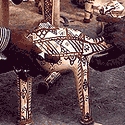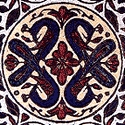Kutch and Saurashtra Gujarat are noted for their beautiful pottery. Practitioners of this craft are also found in Anand district. The ware is white, with delicate designs on it. Bhuj in Kutch has a colony of potters producing clay utensils, tea kettles, bowls and pots for water, miniature toys, grinding stones, furnaces, and griddles. Festival objects like toy elephants, bullocks, and horses are also made by hand. This region is also noted for large grain containers.
Gujarat has a unique tradition of votive terracotta, that follows from the Indus family heritage. Figurines of animals and humans are made from clay and coated with lime. They are then painted upon and are often placed in shrines and sacred groves. The raw material of these products is the mati- red clay, also called terracotta. After the pounding and preparation of the clay, it is moulded by the use of a charkha (spinning wheel). After the moulding, the clay is hand modelled with unique and intricate designs that are very akin to the hand embroidery done on the textiles.



Gujarat has been honing a long legacy of pottery and other producing other rafts such as terracotta and ceramics. Ceramics are inorganic and non-metallic materials that make part of our daily lifestyle. Ceramics can be dense or lightweight, depending on their formation technique. Typically, they will demonstrate excellent strength and hardness properties; however, they are often brittle in nature. Ceramics are generally made by taking mixtures of clay, earthen elements, powders, and water and shaping them in cto desired forms. Once the ceramic has been shaped, it is fired in a high-temperature oven known as a kiln. Often, ceramics are covered in decorative, waterproof, paint-like substances known as glazes.


